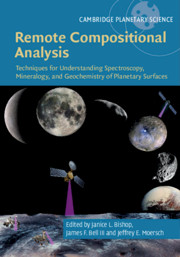 Remote Compositional Analysis
Remote Compositional Analysis Book contents
- Remote Compositional Analysis
- Cambridge Planetary Science
- Remote Compositional Analysis
- Copyright page
- Contents
- Contributors
- Foreword
- Preface
- Acknowledgments
- Part I Theory of Remote Compositional Analysis Techniques and Laboratory Measurements
- Part II Terrestrial Field and Airborne Applications
- 11 Visible and Near-Infrared Reflectance Spectroscopy
- 12 Raman Spectroscopy
- Part III Analysis Methods
- Part IV Applications to Planetary Surfaces
- Index
- References
11 - Visible and Near-Infrared Reflectance Spectroscopy
Field and Airborne Measurements
from Part II - Terrestrial Field and Airborne Applications
Published online by Cambridge University Press: 15 November 2019
- Remote Compositional Analysis
- Cambridge Planetary Science
- Remote Compositional Analysis
- Copyright page
- Contents
- Contributors
- Foreword
- Preface
- Acknowledgments
- Part I Theory of Remote Compositional Analysis Techniques and Laboratory Measurements
- Part II Terrestrial Field and Airborne Applications
- 11 Visible and Near-Infrared Reflectance Spectroscopy
- 12 Raman Spectroscopy
- Part III Analysis Methods
- Part IV Applications to Planetary Surfaces
- Index
- References
Summary
Visible and near-infrared reflectance spectroscopy using reflected sunlight is an ideal tool for remote detection of many compounds. Surfaces can be measured in the field at close range (mm), or from a distance with aircraft or spacecraft. The technology works throughout the Solar System. Advancements have recently been made in sensor calibration and atmospheric correction, enabling faster and more accurate calibration to surface reflectance (or apparent surface reflectance). Parallel to these advancements have been advancements in radiative transfer models, including a better understanding of the scattering effects of submicrometer particles and the ability to model those effects. There has also been progress in spectral analysis, including methods to rapidly analyze imaging spectrometer data to identify and map hundreds of compounds. Finally, with the advancements in computer technology, both in compute speed and in storage, analysis of very large imaging spectrometer data sets is now feasible in a relatively short time. With some additional development, imaging spectroscopy could be used in real time or near real time applications, including exploration of resources to autonomous robots such as spacecraft rovers searching for resources or life on remote planets and satellites.
Keywords
- Type
- Chapter
- Information
- Remote Compositional AnalysisTechniques for Understanding Spectroscopy, Mineralogy, and Geochemistry of Planetary Surfaces, pp. 261 - 273Publisher: Cambridge University PressPrint publication year: 2019
References
- 1
- Cited by


